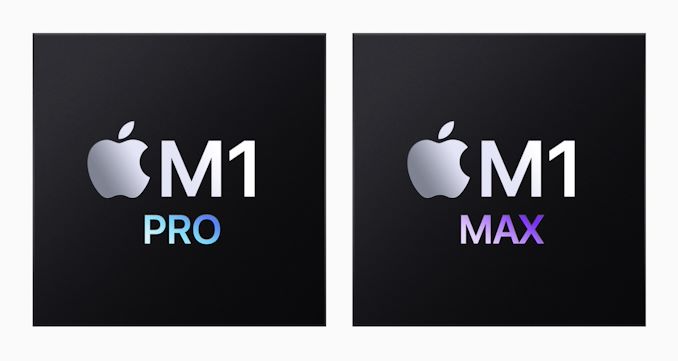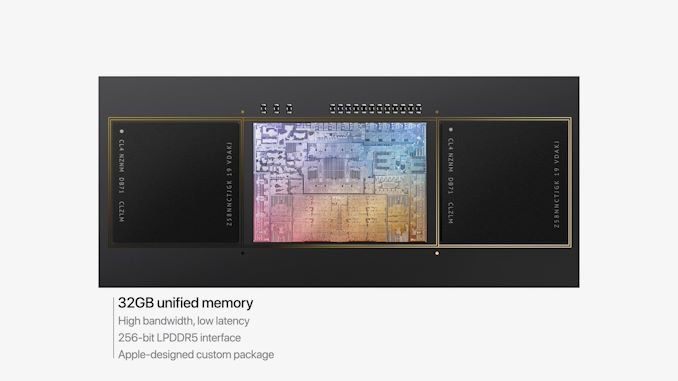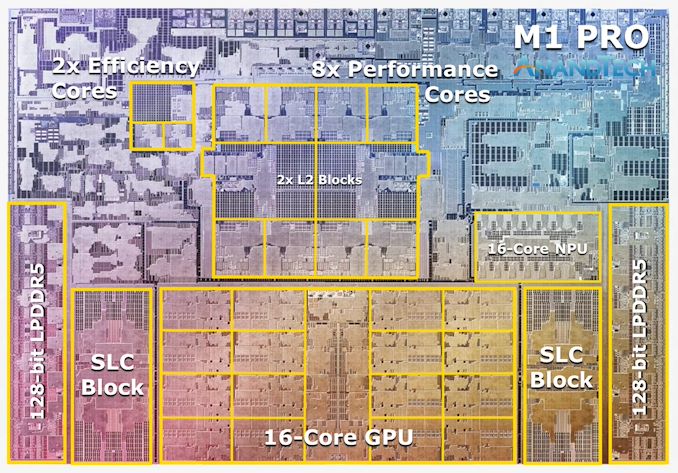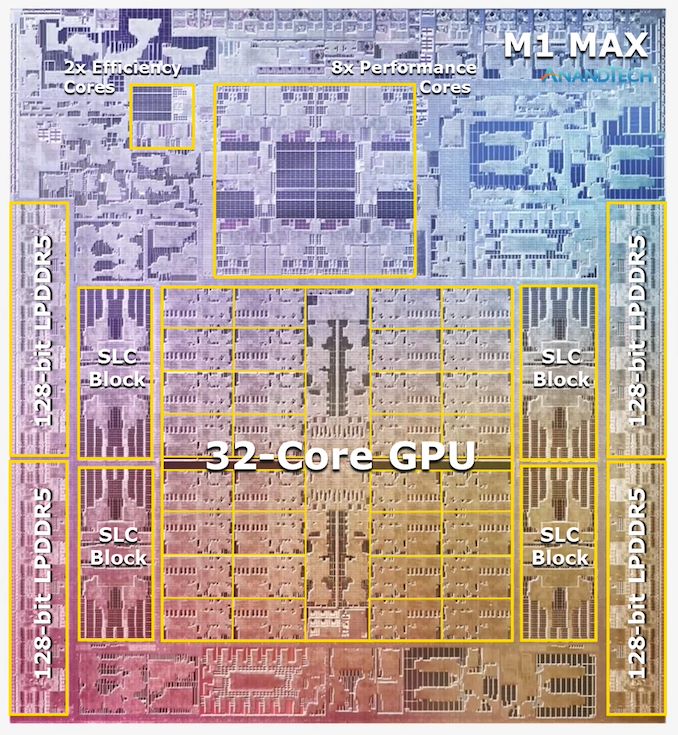Apple's M1 Pro, M1 Max SoCs Investigated: New Performance and Efficiency Heights
by Andrei Frumusanu on October 25, 2021 9:00 AM EST- Posted in
- Laptops
- Apple
- MacBook
- Apple M1 Pro
- Apple M1 Max

Last week, Apple had unveiled their new generation MacBook Pro laptop series, a new range of flagship devices that bring with them significant updates to the company’s professional and power-user oriented user-base. The new devices particularly differentiate themselves in that they’re now powered by two new additional entries in Apple’s own silicon line-up, the M1 Pro and the M1 Max. We’ve covered the initial reveal in last week’s overview article of the two new chips, and today we’re getting the first glimpses of the performance we’re expected to see off the new silicon.
The M1 Pro: 10-core CPU, 16-core GPU, 33.7bn Transistors
Starting off with the M1 Pro, the smaller sibling of the two, the design appears to be a new implementation of the first generation M1 chip, but this time designed from the ground up to scale up larger and to more performance. The M1 Pro in our view is the more interesting of the two designs, as it offers mostly everything that power users will deem generationally important in terms of upgrades.
At the heart of the SoC we find a new 10-core CPU setup, in a 8+2 configuration, with there being 8 performance Firestorm cores and 2 efficiency Icestorm cores. We had indicated in our initial coverage that it appears that Apple’s new M1 Pro and Max chips is using a similar, if not the same generation CPU IP as on the M1, rather than updating things to the newer generation cores that are being used in the A15. We seemingly can confirm this, as we’re seeing no apparent changes in the cores compared to what we’ve discovered on the M1 chips.
The CPU cores clock up to 3228MHz peak, however vary in frequency depending on how many cores are active within a cluster, clocking down to 3132 at 2, and 3036 MHz at 3 and 4 cores active. I say “per cluster”, because the 8 performance cores in the M1 Pro and M1 Max are indeed consisting of two 4-core clusters, both with their own 12MB L2 caches, and each being able to clock their CPUs independently from each other, so it’s actually possible to have four active cores in one cluster at 3036MHz and one active core in the other cluster running at 3.23GHz.
The two E-cores in the system clock at up to 2064MHz, and as opposed to the M1, there’s only two of them this time around, however, Apple still gives them their full 4MB of L2 cache, same as on the M1 and A-derivative chips.
One large feature of both chips is their much-increased memory bandwidth and interfaces – the M1 Pro features 256-bit LPDDR5 memory at 6400MT/s speeds, corresponding to 204GB/s bandwidth. This is significantly higher than the M1 at 68GB/s, and also generally higher than competitor laptop platforms which still rely on 128-bit interfaces.
We’ve been able to identify the “SLC”, or system level cache as we call it, to be falling in at 24MB for the M1 Pro, and 48MB on the M1 Max, a bit smaller than what we initially speculated, but makes sense given the SRAM die area – representing a 50% increase over the per-block SLC on the M1.
The M1 Max: A 32-Core GPU Monstrosity at 57bn Transistors
Above the M1 Pro we have Apple’s second new M1 chip, the M1 Max. The M1 Max is essentially identical to the M1 Pro in terms of architecture and in many of its functional blocks – but what sets the Max apart is that Apple has equipped it with much larger GPU and media encode/decode complexes. Overall, Apple has doubled the number of GPU cores and media blocks, giving the M1 Max virtually twice the GPU and media performance.
The GPU and memory interfaces of the chip are by far the most differentiated aspects of the chip, instead of a 16-core GPU, Apple doubles things up to a 32-core unit. On the M1 Max which we tested for today, the GPU is running at up to 1296MHz - quite fast for what we consider mobile IP, but still significantly slower than what we’ve seen from the conventional PC and console space where GPUs now can run up to around 2.5GHz.
Apple also doubles up on the memory interfaces, using a whopping 512-bit wide LPDDR5 memory subsystem – unheard of in an SoC and even rare amongst historical discrete GPU designs. This gives the chip a massive 408GB/s of bandwidth – how this bandwidth is accessible to the various IP blocks on the chip is one of the things we’ll be investigating today.
The memory controller caches are at 48MB in this chip, allowing for theoretically amplified memory bandwidth for various SoC blocks as well as reducing off-chip DRAM traffic, thus also reducing power and energy usage of the chip.
Apple’s die shot of the M1 Max was a bit weird initially in that we weren’t sure if it actually represents physical reality – especially on the bottom part of the chip we had noted that there appears to be a doubled up NPU – something Apple doesn’t officially disclose. A doubled up media engine makes sense as that’s part of the features of the chip, however until we can get a third-party die shot to confirm that this is indeed how the chip looks like, we’ll refrain from speculating further in this regard.














493 Comments
View All Comments
NCM - Monday, October 25, 2021 - link
@guy23929: The M1 Max processor is a BTO option for the 14” model. See https://www.apple.com/shop/buy-mac/macbook-pro/14-...Ppietra - Monday, October 25, 2021 - link
it can also be sold with the M1 Max, it’d a build to order option.photovirus - Monday, October 25, 2021 - link
This is not correct. You can totally customize a 14" to have an M1 Max w/ 32-core GPU. (There's no Max-equipped *base* model, though.)sirmo - Monday, October 25, 2021 - link
My guess is 14" will be power limited more. Since I bet it doesn't have the cooling capacity to handle 120 watts.hmw - Monday, October 25, 2021 - link
Unless the 16" uses a very different cooling design over the 14", it's not likely to be that much bigger. Say it's capable of dissipating 120W - and the 14" will handle 100W. In this case the 14" would spin the fans harder and handle that extra load. So perhaps the limitation is artificial ?photovirus - Wednesday, October 27, 2021 - link
Sure, I think it will. However (IMO) there aren't that many workloads which will saturate both CPU and GPU simultaneously to stress the thermals. If any one is underutilized, then the bottlenecking one will run at 100% speed.I think, 14" Max will be as fast as 16" Max for most people. At 1.6 kg, this powerhouse is surprisingly portable.
maroon1 - Monday, October 25, 2021 - link
Apple is bad for gaming.... less games than windows 10 and get destroyed by nvidia GPU because of poor optimizationsComputeGuru - Monday, October 25, 2021 - link
Sadly until Apple gets on board with gaming, these Macs and their exceptional power efficiency are going to remain a niche product.These new Macs are definitely a very nice product to that small subset of people who need it's processing power for their specific workloads, but this is still a product that is not for the masses. It would be nice to see all computers sip power like these new Macs but until Mac actually becomes a threat to the Windows market by giving the masses the biggest legit reason to buy a Mac (no compromise gaming with access to all games) sadly this will take a while as well.
Focher - Monday, October 25, 2021 - link
Can you let us all know when Apple gave a crap about gaming on Macs? Because every time Apple releases a new Mac product, there are inevitably a bunch of posters about Apple being bad at gaming. Very insightful.These machines are designed for digital workflows. Transcoding video. Rendering. Publishing. Machine learning. It's pretty much a guarantee that Apple's engineering teams do not have a single AAA game in their mind when designing silicon. Yet here we are again having to scroll through useless comments about gaming support on a Mac.
Alistair - Monday, October 25, 2021 - link
It's because of the pricing. You can buy a $1000 laptop with a Ryzen 5900H if all you need is CPU performance. I don't find Apple products compelling without gaming chops. Neither do most people.